The Student Union

Powered by students, sponsored byOjai Valley News
May 17, 2024


May 17, 2024

It’s extremely windy, sunlight is fading behind the mountains and it’s raining — hard. e raindrops land on the cement like bullets. It is only 50 degrees outside and nobody is around — except a certain few people, who have no choice but to be outside.
Behind Ojai’s City Hall — a beautiful Spanish revival style building, encircled by well-maintained shrubs and fronted by a fountain endlessly owing with water a starker vision lays bare a sobering truth, especially after an unseasonably rainy and cold winter: a sprawling homeless encampment of tents that rst sprouted two years ago, continuing to serve as a makeshift community for roughly 30 people.
While Ojai is well known in California and beyond as an a uent community and popular tourist destination with breathtaking mountain views and high-end hotels and restaurants, homelessness, despite popular belief, is prevalent.
“My grandpa was here since the roads were dirt,” says Kristen Wingate, 52, who has family roots in Ojai and has been living in the encampment for several months. She’s dressed in a blue pu er jacket and sweatpants, has a hood covering her brunette hair, and is wearing a pair of running
shoes. She is short in stature and speaks with a raspy voice.
“People who have lived here for only months have mansions. It’s hard out here when it starts raining. People get sick,” she says. Melissa Balding, 48, has been an Ojai resident for ve years. She says last summer she was victimized by a scam in which she lost a large sum of money she invested in a local taxi company. She’s now Wingate’s neighbor, living in the encampment behind Ojai City Hall and on this night, she braves the rain and cold wearing tights, a T-shirt, and a beanie.
“What I hate the most,” says Balding, “is when people make assumptions about us. We’re all good people who just got unlucky.”
Ojai residents have voiced mixed opinions about the encampment and how City Hall and Ventura County authorities and organizations are responding to aid the unhoused population.
“I have talked to people that think it is great that [unhoused] people are allowed to stay. I have talked to people that are very much against [it],” said Scott Garner, a Ventura County Sheri ’s deputy, who works for the Sheri ’s O ce homeless liaison unit. “I will say I received a lot more complaints and concerns when people were living in the city parks.”
“We’re all good people who just got unlucky.”
— Melissa Balding
Garner schedules backpack medicine outreach to encampment residents. He emphasized, though, that volunteers — many of whom include doctors, nurses, social workers, counselors, and representatives from various homeless shelters — deliver much of the needed aid.
“We have seen an increase in homelessness in the past four years,” said Whitney Nunes, a case worker for Help of Ojai, a nonpro t organization that strives to help unhoused people nd temporary housing.
“ e majority of the [unhoused] people are elderly, the majority of [whom] have lived in Ojai for 20-plus years,” Nunes continued, “with very few of them moving here later in life. People are selling their houses at high prices as rent continues to rise, and a lot of elderly people are on xed incomes. [But] seniors aren’t the only ones becoming homeless; everyone is.”
Ojai Valley School junior Valentina
When the clock strikes 6:30 a.m., Katie wakes up and reaches for her phone. She opens her Instagram and scrolls through her feed.
After an hour of mindless scrolling, she gets up and gets dressed, only to nd that her jeans aren’t zipping up. She stands there, looking in the mirror, and thinks back to her Instagram feed, lled with photos of girls with small waists and at stomachs.
When her mom o ers her breakfast, she declines and begins to put on makeup. She looks at her skin and bursts into tears. e beauty standard set by social media is overwhelming and feels impossible to meet.
She decides to take a mental health day because the thought of attending school is daunting.
“Every time I open my phone and scroll through social media, I feel like shit. Online… it looks like everyone’s life is perfect and I constantly wish I could have that,” said Katie.
High school freshman Katie isn’t the only girl who struggles with feeling insecure after scrolling through social media. According to dosomething.org, 95% of teens are on social media and 37% have been bullied online.
Ojai Valley School recognized this issue and hired Robert Brunelle as a guidance counselor to support students’ mental health. Brunelle has a lot of students coming into his o ce with anxiety due to social media and has seen rsthand the consequences it can have on young people.
Social media provides easy access to dopamine that stimulates the brain and provides pleasure.
“Everyone in high school — their brain currently has an emphasis on seeking pleasure, attention, and emotions that are in the moment,” explained Brunelle about why social media is so attractive and addictive to teenagers.
Social media provides an alternative to in-person conversations. Teens often use social media as a distraction to avoid having real conversations where problems are resolved, resulting in a lack of social communication skills.
“I think social media becomes an avoidance of things, which means we aren’t practicing the skills to change [things],” said Brunelle. “Unless you learn skills to actually talk to that person… it’s not going to change what’s going on. So I think it makes it easier to avoid problems.”
Ojai Valley School senior Alula Alderson
At 17 years old, it had never occurred to me that I have a place in the sphere of local politics. But just last month, I stepped up to the microphone at a City Council meeting to advocate against rodenticide usage in the Ojai Valley — a topic I feel passionately about as an environmentalist and animal lover.
“My voice and opinions are heard and ampli ed.”
— Ama Okigbo, acher junior
With the introduction of the Mayor’s Youth Council, I’m now part of a group where I feel I have the platform and support to help create the changes I want to see in my community.
“My voice and opinions are heard and amplied,” agreed my Youth Council peer Ama Okigbo.
“I can talk to the Ojai council and be an advocate for positive change from the youth perspective.”
Mayor Betsy Stix came up with the idea for the council last spring, inspired by youth commissions in other cities. “Its mission is to teach Ojai Valley high schoolers how city government works, to familiarize the students with local issues and
help them identify bold solutions to these issues, and to encourage them to participate in local government by sharing their opinions on speci c council agenda items, either in person or online,” she summarized.
e idea of bringing younger voices and new perspectives to the City Council was exciting to Stix. “I think this is what we really need,” she said. “To solve… the problems that we have on our planet, we need di erent ways of looking at issues — a much more holistic approach — because we are all connected and everything we do a ects everybody around us.”
On Sept. 26, the initiative was approved at the City Council, and on Nov. 7 the group assembled for the rst time.
Today, the Youth Council is made up of over 25 students, myself included, from all six local high schools Nordho , Ojai Valley School, acher, Villanova Prepatory, Oak Grove, and Besant Hill. Youth Council co-chairs Chris Engel, Kathryn Hotchkiss, and Peggy Grunert, as well as Stix herself, facilitate the meetings; while Air Pizza owner Tere Karabatos generously provides a meeting space and pizza for the monthly reunions.
At the rst couple of meetings, everyone made introductions and shared what they believe are the biggest issues impacting Ojai’s youth.
 Edelson
Besant Hill School sophomore Eli Gershovich
Edelson
Besant Hill School sophomore Eli Gershovich

Dear reader,
In an increasingly polarized world, journalism is more important than ever. By exposing people to new perspectives and ideas, it has the power to foster empathy and bridge connection.
It has been such an honor to serve as Editor of the Student Union this year. I’m thrilled we were able to keep this valuable project alive and I hope the Student Union can continue to empower young writers in the community for many years to come.
A huge thanks to the Ojai Valley News team for making this publication possible, the participating high schools for funding it, and most of all, the featured students for their incredible writing and reporting.
Special shoutouts to Besant English teacher Gil Gri n, who took it upon himself to teach a handful of students the fundamentals journalism in only a week; my dad, John Alderson, for giving up his time to help me learn the ins and outs of Adobe InDesign; and OVS journalism teacher Fred Alvarez for his support and guidance throughout the entire process.
I’m so excited to share this diverse collection of stories with you, shedding light on the interests, passions, and talents of Ojai’s youth. Happy reading!
— Ojai Valley School senior Alula Alderson
What is the Student Union?
e Student Union is a student-run paper sponsored by the Ojai Valley News featuring the work of student journalists from across Ojai. It was revived last year by former OVS senior Hannah Little. e Union o ers high schoolers the opportunity to get real-world journalism experience and a platform to make their voices heard.
How can I get involved in the Student Union?
If you are a high school student in the Ojai Valley interested in submitting to the next edition of the Student Union, please contact union@ojaivalleynews.com

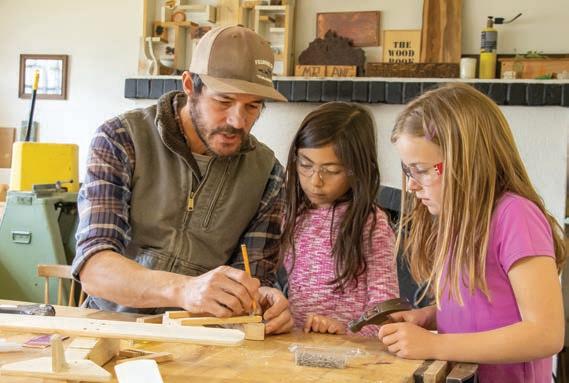
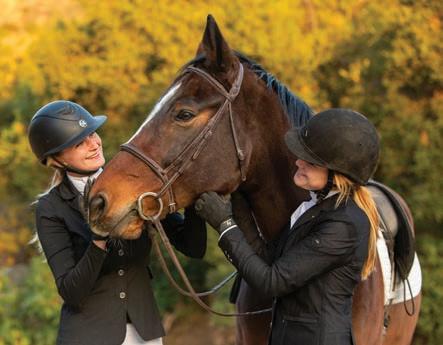
HOMELESS: CONTINUED FROM PAGE C1
“We don’t have much to do with [the Ojai encampment],” Nunes said, “but we help individuals who come to us asking for help.”
Balding and Wingate have. ey call Nunes their “guardian angel.” Nunes, they said, visits them and looks after many homeless people individually.
Both Wingate and Balding describe encampment residents as “a family.” ey said they’re grateful the city has allowed them to stay in the encampment and that they feel safe there, and called their living conditions “good enough.”
Since the encampment rst appeared, the city of Ojai, with help from nonpro t organizations, has provided a small number of sturdy tents mounted on wooden platforms, and has begun providing residents with food, water, and medical attention.
However, there is great daily adversity Wingate, Balding, and other encampment residents face, for which neither the city nor the county have easy solutions.
Hygiene is a serious issue.
Encampment residents have limited options to bathe. Balding and Wingate also claim that some city residents have called in fake reports to the authorities of encampment dwellers starting nonexistent bon res in an attempt to have their temporary homes dismantled or removed.
Still, the majority of people living in the Ojai encampment are using store-bought tents and don’t yet have access to the mounted, higher-quality tents, closest to Ojai City Hall.
While the city of Ojai struggles with nding ways to help the unhoused population and deal with public opposition, homelessness persists. With nonprofits being understa ed, more and more people of all backgrounds are slipping through the cracks, unable to get the help they need.
“Sometimes it feels like we’re getting as much help as possible,” Balding said. “Other times it feels like Whitney’s the only one that cares. Most people are just a paycheck away from being in our position.”
(Editor’s note: Since this article was written, the city has received a state grant of $12,667,461 million to help the unhoused.)

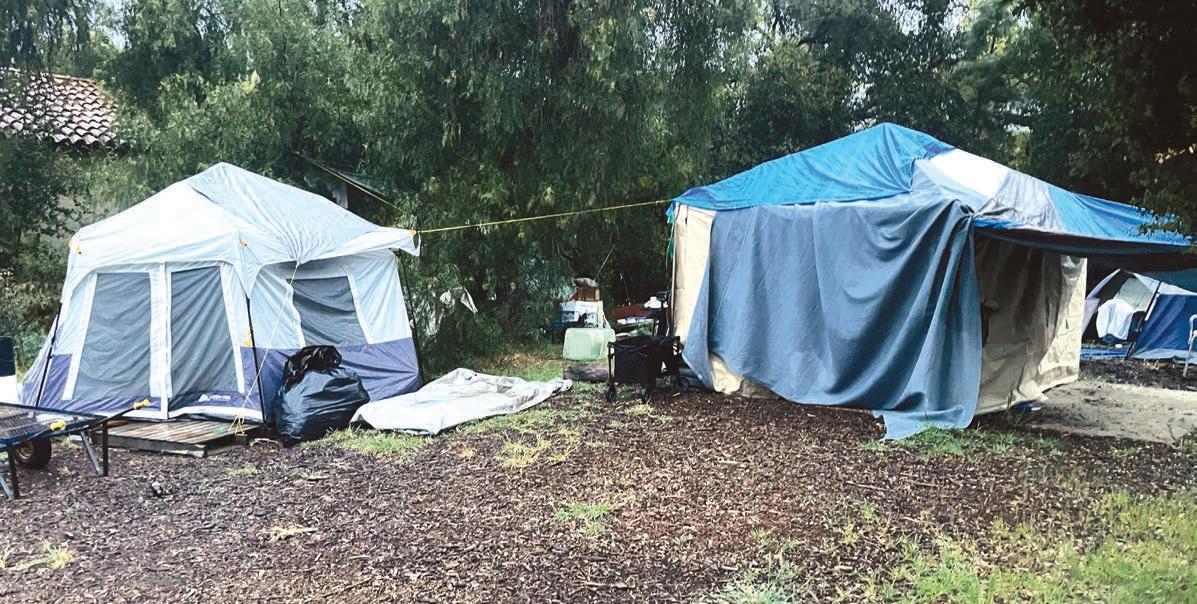















Villanova Prepatory School
junior Maeve McCormick
Community plays a vital role in our lives, but nding that community can be challenging.
It can be especially hard for international students to nd connection within a new, unfamiliar environment. Recognizing this, Villanova Preparatory School hosts an International Day every year in March to celebrate students’ cultures and to help implement a sense of community within the school.
“As an international school, we have an obligation to share how diverse we are,” said Señora Seligman, one of Villanova’s Spanish teachers.
On International Day, hours of preparing food and practicing dances come together to form a surplus of festivity and excitement. Scents from all around the world waft across Villanova’s campus as students, parents,
and teachers collaborate to prepare dishes from di erent countries. Students can accumulate a plate of food from each country represented, every bite o ering a taste of a distinct culture.
Students can accumulate a plate of food from each country represented, every bite o ering a taste of a distinct culture.
“It’s a community event,” said Señora Seligman. “We are able to showcase the diversity of our campus and the di erent cultures we have.”
Following this feast, the school prepares to watch the long-awaited production of traditional performances. ese performances vary from the astonishing footwork of Scottish dancing to the graceful expression of Chinese dance.
“It shows how proud students

are of their heritage,” said Señora Seligman.
International Day not only gives students the opportunity to share their cultures with the community, it allows them to grow closer to their identities and establish ties with peers of common backgrounds.
Senior Izabelle Aguirre has



been an active participant in International Day throughout her time at Villanova, as she values showcasing her Filipino heritage to the school. is year, the Filipino club wore the traditional baro’t saya (“blouse and skirt”) and performed the “itik-itik” (“duck”) dance, named for its resemblence to the movements of a duck. ey also served limpia (“spring rolls”), pancit (“stirfried noodles”), and halo-halo
(“mix-mix”), an assortment of toppings over shaved ice and condensed milk.
ese things uni ed many students of Filipino descent. “It’s really nice to have a strong, stable community that can resonate with my culture,” Izabelle said.
She has observed how International Day brings students from di erent backgrounds together. “I think it’s important because there are so many people that come to Villanova who are
from a di erent background and it’s a very diverse community, so it’s good that we get to highlight and emphasize this great portion of our school and what it can o er other people,” she said. “It can also be a good learning experience for people who are very sheltered and aren’t exposed [to diversity].”
Altogether, Villanova’s International Day helps develop an indispensable feeling of connection among the student body.














Sophomore Sarah got social media later than a lot of her friends, as her parents were hesitant to send their daughter into what they perceived as an online world full of hate. Many parents are cautious about giving their kids access to social media, believing they will be bullied or become addicted.
However, Apple has a feature called “screentime” that allows parents to set a speci c amount of time their child can access a speci c application. Sarah, like many others her age, has a screen time limit, only allowing her to be on each social media application for a maximum of 3 hours a day.
“My parents have always been skeptical about social media, and often as a punishment take it away,” she said. “I feel like they don’t understand that I don’t only use it for entertainment, but also to connect with my friends.”
Many teens use social media to connect with friends and family. Sarah believes people have forgotten the positive parts of social media.
“I love hyping my friends up on their posts,” she said. “People are so obsessed with the negative side of social media that they forget about the good side.”
Like Sarah, sophomore Maria views social media as a tool to connect with friends.
“I attend a boarding school… and social media helps me keep in contact with my friends from back home,” she said. “Simply snapping pictures back and forth gives me a small glimpse of life at home.”
Maria’s parents, similarly to Sarah’s, were hesitant about allowing their young daughter to access social media and they monitor her accounts.
Many teens stress about the number of likes and reposts they get on a post, seeking validation and comparing themselves to others. Katie struggles with this and often has anxi-
ety about posting.
“Sometimes when my post doesn’t get enough likes I think to myself is it because of how I look,” she said. “I think body image is a struggle for a lot of teen girls and social media combined with Photoshop makes an impossible standard.”
Many teens receive hateful comments and negative backlash from posting.
“ ere’s been multiple instances in which I have received a hate comment or heard people making fun of my social media and it has genuinely hurt me,” said Katie. “I swear that if you don’t have a perfect hourglass body, a good nose, straight teeth, and importantly, a at stomach, you are seen as less than. Kids often care more about looks than personality and those standards are hard to t.”
Brunelle believes many teens don’t use social media the right way, making unhealthy comparisons.
“For a healthy comparison, [you] would say ‘I admire this person’ and [ask] ‘how can I... do some of the things they are doing because I want to get where they are?’” explained Brunelle. “You can’t just get the product without going through the process, which often isn’t shown.”
While social media can be used as a reference, you can’t believe everything you see on the internet and doing additional research is often necessary.
However, some teens recognize that people’s lives and appearances on social media often are fake or edited.
“Everyone’s lives look perfect on social media but it’s fake. Obviously, no one’s going to post something they feel ugly in,” said Maria.
Although social media allows for communication between friends, it is undoubtedly a ecting the communication skills, mental health, and body image of teenagers, and especially teenage girls.
(Editor’s note: Names in this article have been changed for anonymity.)



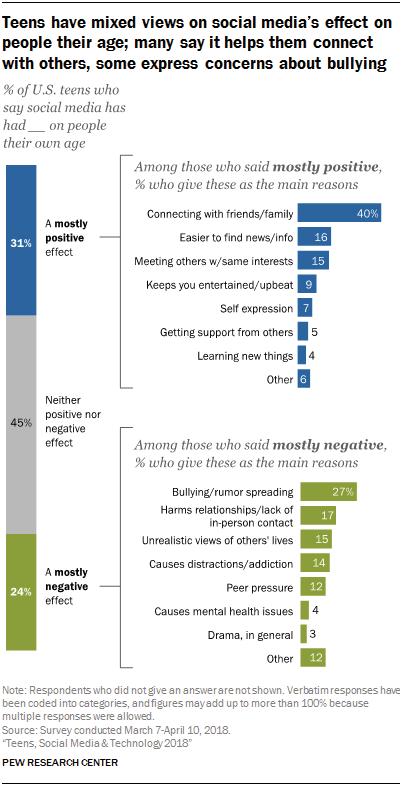

Ojai Valley School senior Allyanna Westcott
It’s 4:30 a.m. Ojai Valley School junior Malak Masoud’s alarm goes o . She heads to the dark, empty girls lounge to cook eggs and toast. e sun has not yet risen. After she eats, she washes her dishes, drinks lots of water, and sleeps for another hour before participating in a full day of classes and sports without any food or water.
Malak and her brother, Senior Yousef Masoud, observe Ramadan, an Islamic tradition of a monthlong fast and time to focus on spirituality and empathy.
In the morning, Yousef and Malak wake up before the sun comes out to make and eat suhoor. Suhoor is the meal eaten before dawn (for context, dawn is around 6 a.m.), as well as the last meal not eaten until after sunset, (which is after 7 p.m.). is means there are over 13 hours between the two meals. Yousef wakes up around 5:30 a.m. to eat, while Malak wakes up around 4:30 a.m. to cook herself food.
Living quasi-independently, away from home, Malak has to cook for herself. “It is harder because I have to make my own food,” she said. When she lived at home, her parents would often cook. Now, she wakes up earlier to prepare Suhoor for herself and clean up after.
To last the day without food, Malak and Yousef focus on eating protein and ber, which take longer to digest and provide more lasting energy. Yousef eats foods such as yogurt or peanut butter. Malak also focuses on protein and likes to eat vegetables to ensure she is getting enough nutrients.
After eating and drinking lots of water, they go back to bed until it is time for school.
In countries where Islam is more widespread, such as Saudi Arabia where Yousef and Malak attended school many schools start later in the day during Ramadan, to give students more rest after waking up so early. With the old schedule, Malak would wake up at 10.
Malak feels the di erence between Ramadan in Saudi Arabia and Ramadan in Ojai. e people who did not fast non-Muslims and people with medical issues were in the minority in her home country. “It felt like that month, it revolved around fasting,” she said.
Additionally, fasting fostered community. “All the kids are doing this, so it’s not only me. So we’ll all show up like ‘Yeah, I didn’t sleep last night’ and we’ll laugh about it,” she said. “ ere’s a change in that sense.”
However, at OVS, the schedule is less accommodating. School starts at 8:10 a.m.. Yousef said he only gets about an hour of rest after eating before waking up again for school.
Additionally, like most boarding students, Malak has a roommate. “Adele would need to get ready, and I can’t blame her for turning the lights on. And I’d sleep even with the lights on,” she said.
In Saudi Arabia, the schedule would also change to shorten classes, passing periods, and the lunch period. “It’s really di erent. De nitely miss the old schedule,” Malak said. “Our brain doesn’t go overtime.”
“Also, there wouldn’t be homework. And they would minimize tests,” said Malak. “I recommend all teachers do this from now on,” she joked. “But
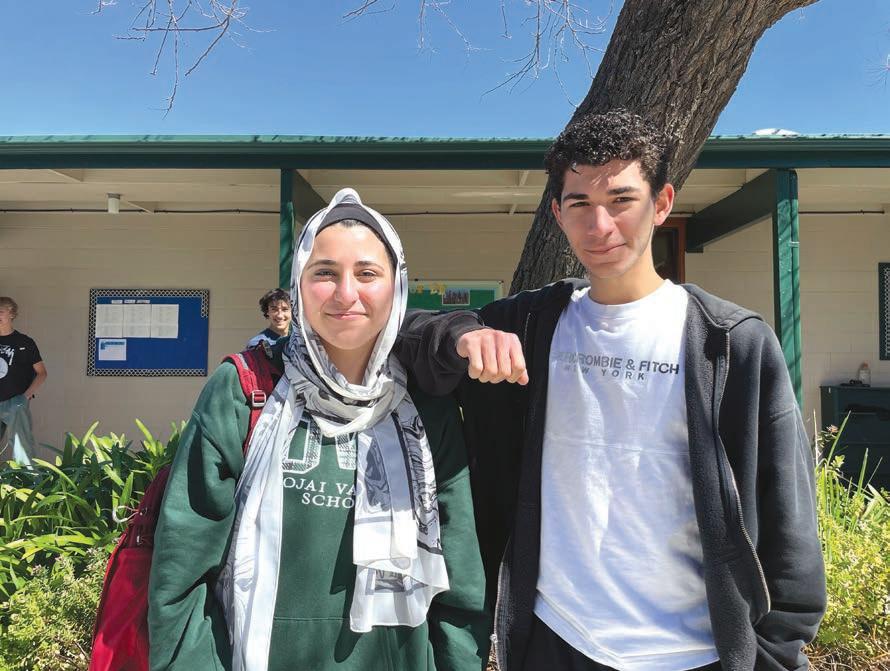
Besant Hill School freshman
Shuqi Zhang
n cheerful herds, Besant Hill
ISchool of Happy Valley students and sta begin ocking to the school’s soccer pitch. It’s bright, sunny, and calm, but the sun’s rays are beaming more intensely than usual. At rst glance, this gathering may appear like nothing more than a school-wide picnic.
But the community of nearly
100 students and their teachers have been mandated to come here, per the directive of a special schedule, to observe a rare phenomenon the recent total solar eclipse on April 8 that captured the world’s attention and fascination.
Many students arrived with blankets, snacks, and drinks, all too eager to spend a two-hour block lying in the grass and witnessing many for the rst time the unfolding eclipse
overhead.
“It’s a really good time to just kick back and relax, and look at the eclipse and take a break from school,” said Sydney Rubinek, an 11th grade student. “It’s a unique experience. We won’t be able to see [the eclipse again] for a long time.”
Like Rubinek, many of her peers made use of the clear sky and provided solar viewing glasses to study the starlight bending as it did in 1919, when

now there are tests, and there’s lots of homework.”
Sports is another challenge when abstaining from food and water. Yousef played three volleyball games right at the beginning of Ramadan, but he said fasting didn’t a ect his ability to play his best.
“Sports takes your mind o of food,” he said. “If you get really into a game, you won’t realize you’re hungry or don’t have any energy.”
Junior Andrew Little plays on the volleyball team with Yousef. “I’m not joking, but he’s all of a sudden playing way better,” he said.
In Saudi Arabia, Malak used to sleep right after school until she woke up to break her fast. en, she would do homework for an hour and a half, and stay up, talking to her friends. Now, she has to wait and sleep as soon after study hall as possible. Sometimes, she has di culty falling asleep so soon after eating.
After their full day of school, Malak and Yousef go to the cafeteria to make their dinner.
“My food nowadays isn’t what I used to have during Ramadan,” Malak said. “You break your fast with dates and water. And you say a prayer, or a dua, before you break your fast,” she said. “And then you drink soup. ere’s lots of soups, because you need the water. Most of them have some sort of protein, whether it’s lentils or pieces of meat.”
Now, Malak and Yousef break their fast with whatever the cafeteria serves.
However, they don’t eat during dinner. ey put the food in boxes and wait until after sunset (around 7:15 p.m.) to break their fast and eat in their dorms.
Yousef says fasting helps him feel more empathetic and grateful. “You get the pleasure of eating and you’re like ‘Wow, I went through this whole day without eating and now I’m full and happy.’ So we become grateful, and we thank our
God,” he said.
Malak’s mother had their family download a Quran reading app, which can send timed reminders to read the holy text and record the time they read for.
“I think it’s sort of like a competition now,” said Malak. “My mom has a lot of free time, so she’s beating us all. She would just send the scoreboard, and she’s like ‘Good job guys!’, and she’s teasing us because she’s doing better than everybody else and reading more pages.”
Additionally, Malak said this is a good time for self-improvement. “ is is the time that all the devils are locked up,” she said. “[Your bad habits] are your own actions and you can’t blame it on the devils.” erefore, she says Ramadan is a good time to recognize bad habits and set goals for yourself.
Moreover, Malak said Ramadan is a time to become closer to God, and prayers are more likely to come true. “It’s a time to cleanse yourself from the year,” Malak said.
Yousef thinks students should try practicing Ramadan for a worthwhile experience, even if just for a day. “You will de nitely feel more empathetic. at’s something everyone should feel,” he said. For anyone wanting to try Ramadan, Yousef shares a few pieces of advice:
First, wake up 30 minutes before sunrise to eat. If you eat too early, you’ll get hungry quickly. Second, eat ber and protein for longer-lasting energy. Avoid carbohydrates, which don’t last long. ird, drink plenty of water before the fast. Fourth, he said “Just go on about your day. Don’t push yourself.”
Malak welcomes questions. “I like the questions when [others are] curious. I think it’s sweet,” she said. “Lots of people were asking about Ramadan. It makes me feel like they care.”
Einstein’s eory of General Relativity was proven, thanks to a total eclipse much like this one. Other students and some teachers opted to play soccer and frisbee under the eclipse.
Still, some students, including Nina Bazyler, were focused more on their studies than on celestial phenomena.
“I had AP classes this morning,” she said. “I would’ve preferred a longer time for reviews and to spend more time in my
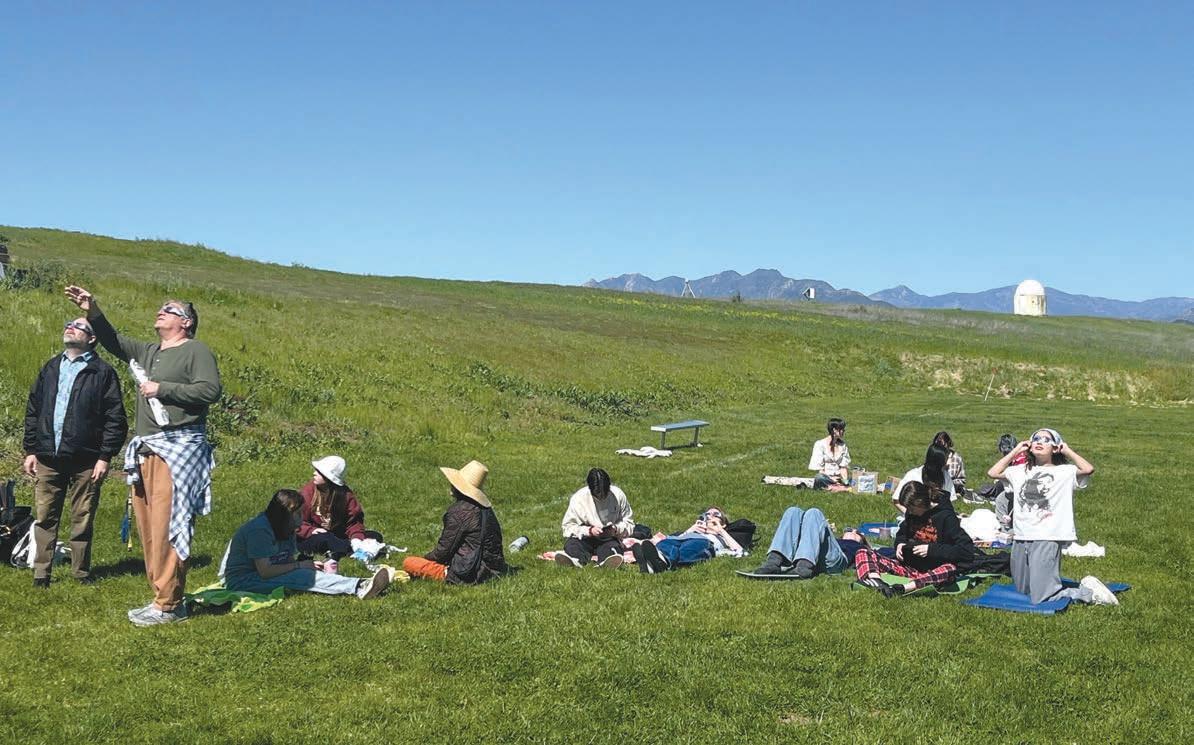

share with
AP classes.”
Néstor Geronimo, a 15-year Besant Hill teacher of Spanish and French, said while the two-hour window was long, he was pleased for students who’d never seen an eclipse to take that amount of time.
“If this is your rst experience with [an eclipse], it’s ne, so you can see it from beginning to end,” Geronimo said. “ at was the idea of having a twohour block, for students to experience it from when it starts to when it ends.”
Hill’s math and sciences
was
instrumental in planning the school’s event, which followed a special “math and science week” beforehand. He distributed dozens of pairs of protective solar viewers to students and teachers.
“[ e eclipse] certainly has educational value,” Maddalone said. “It’s the combination of education and building community… We’re all out here today, we’re talking about the eclipse, we’re talking about science, we’re talking about the sun. We’ve been brought together as a community by a pretty historic event.”

Villanova Prepatory School
junior Paige Atkins
In the heart of the Villanova Preparatory School’s community, a beacon of compassion shines bright: Victoria’s Sparks of Joy, a high school club founded in 2021 by junior Samantha Cordero, is making a signi cant impact in the ght against cancer.
is club is part of a larger nonpro t by the same name founded by the Smitherman family, whose daughter Victoria battled brain cancer for ve years before passing away in 2016 at age 15. Her memory is what drives the passion within
the organization.
to join hands in the battle against cancer.
“ e Sparks of Joy club aims to bring the community of Villanova students together in an attempt to raise awareness of childhood cancer,” said Cordero. roughout the year, we make monthly themed cards and posters for holidays such as Christmas, Valentine’s Day, Mother’s Day, Halloween, etc.” ese cards are sent to children at di erent cancer organizations in the hopes of providing them a “spark of joy”.
“All cards are handmade with love by Villanova students [who] are dedicated to the mission of serving ill children in the area,” said Cordero.
During September, the club also promotes cancer awareness at school by wearing gold-colored ribbons, representing their support for children battling the disease.
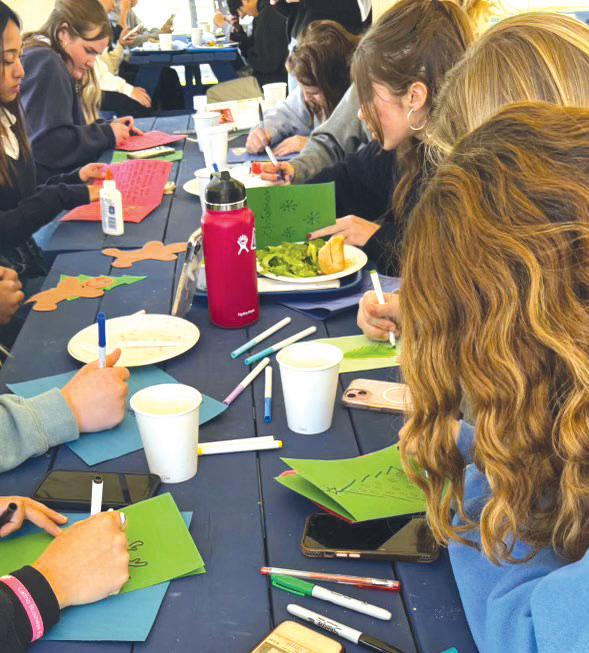
“En Garde, prêt, allez!”
With those words, the metallic clashing of two combatants’ swords begins and the beeping of a small counting machine rings throughout the room. A life-size cardboard cutout of the “Pirates of the Caribbean” swashbuckling character, Jack Sparrow, stands out in the corner, seemingly watching over the young fencers. is room, inside an Oxnard storage facility, is Points West Fencing Center, the training home of 35 athletes of varying ages, genders, and backgrounds. Since the beginning of the year, Points West has seen a big increase in its number of fencers, with founder Mike Ti any saying 24 students between the ages
[Victoria’s Sparks Of Joy] has become a symbol of resilience and generosity in the Villanova Preparatory community.
“Victoria strongly believed that every challenge she faced with this complex and painful disease was easier when she faced it with joy, faith, positivity and a generous spirit toward the medical
eir mission is to fund and
of 6 and 18 have joined his club.
Anneli Cadena, a 16-year-old junior at Oxnard’s Channel Islands High School, joined long before, after being inspired by fencing events she watched on TV in the 2021 Summer Olympic Games in Tokyo.
“ e better I became, the [more] I felt… con dent in myself and my ability to fence,” said Cadena, also a cross country runner, whose rapidly developing skills earned her a place in the 2023 Junior Olympics Fencing Championships.
Cadena appreciates how stamina factors into both longdistance running and fencing. She joined Points West because it was close to her home and a ordable. Fencing, Cadena

support cancer organizations such as e Ronald McDonald House, e Los Angeles Children’s Hospital, and the Ventura County Medical Center, o ering hope and healing to children battling this relentless disease. Having been a close friend of Victoria Smitherman, Cordero felt inspired to bring Victoria’s Sparks of Joy to her school in the form of a club.
It has become a symbol of resilience and generosity in the Villanova Preparatory community. rough fundraising initiatives, educational campaigns, and outreach e orts, the club has gathered students, teachers, and community members
America Perez, a dedicated member of Victoria’s Sparks of Joy, shared her perspective on the club’s mission: “My friend Samantha Cordero inspired me to join this club. I saw it as an impactful way to spend my lunch period, as it seemed a great way to bring some joy to others,” she said. “I could also see how passionate my friend Sam was about this organization and its mission. is further inspired me to participate and share in her passion.”
Another member, Sophia Paine, highlighted how this organization di erentiates from other clubs at Villanova. “Sparks of Joy is unique because it’s one of the most active clubs on campus. Everything we do goes directly to someone in need,” she said. “It creates a more personal connection within the community.”
rough small but meaningful acts of kindness, Victoria’s Sparks of Joy is making a positive impact on the lives of cancer patients and their families, igniting a brighter tomorrow.

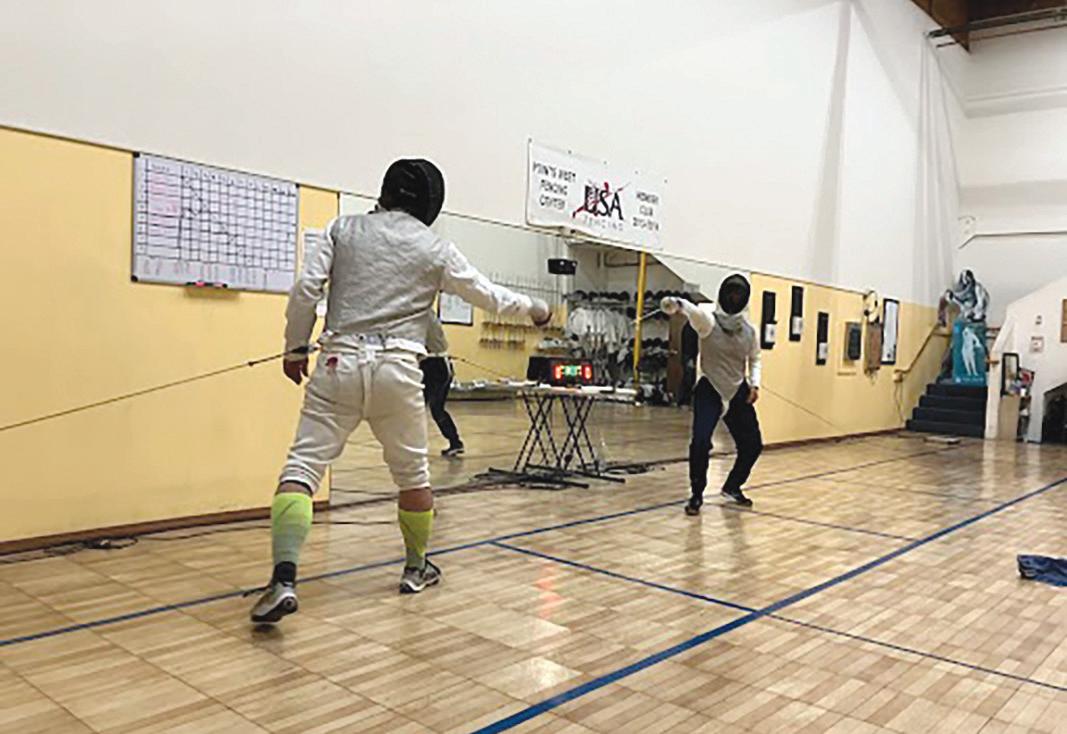
said, has helped grow her selfcon dence.
“It helped me go from a quiet kid,” she said, “to being more comfortable to speak with people. It helped me be more brave.”
Ti any strongly believes the Tokyo Olympics Gold Medal performance of American Lee Kiefer the No. 1 FIE (Fédération Internationale d’Escrime) ranked foil fencer may have increased interest in the sport and driven more students his way.
He also reasoned that a more recent pop culture phenomenon, the 2022 Net ix hit series, “Wednesday,” which in one epi-
sode features an intense fencing scene between two characters, might also be attracting more young fencers.
e USFA (United States Fencing Association) now has nearly 40,000 members nationwide, and is continually growing. Fencing consists of three di erent weapons épée, sabre, and foil with di erent rules for each. e Points West Fencing Center specializes in foil. Ti any himself has been fencing since 1978 and six years later volunteered at the fencing events at the 1984 Olympic Games in Los Angeles.
“ at was the turning point for fencing in the United States and the growth of youth fencing,” he said.
Despite steady growth from that point on, in 2020, when
“Fencing is like chess in real life.”
– Salene Dang, Ventura High School freshman
the COVID-19 global pandemic forced most of the world’s population into isolation, most of Ti any’s students stopped fencing. But after local COVID-19-
related restrictions were lifted, Ti any said a new generation of fencers, including Cadena, has emerged in his class. Most of his young students are from Ventura, Oxnard, and Ojai.
“Ever since I started fencing, I feel a lot more levelheaded,” said Salene Dang, a 15-year-old Ventura High School freshman, who said she started coming to Points West a year ago, after watching last year’s Junior Olympics Fencing Championships.
“I’m a lot quicker at making decisions now. [Fencing is] like chess in real life.”
POLITICS: CONTINUED FROM PAGE C1
Almost every student named the climate crisis as one of their top concerns, so we split up into smaller teams and began to brainstorm Ojai-speci c environmental problems and potential solutions. e diverse ideas we came up with addressed everything from pesticide usage and oil and gas fracking, to drought and wild re danger. “You all were so inspiring and passionate… that it gave me such hope for the future,” said co-chair Engel.
We also visited the Ojai City Council website, reading through the agenda items and previous minutes to get a sense of how the City Council meetings work. en, we began to hear from guest speakers during the sessions, who provided us with information about local organizations. Among these were Jayn Walter, co-executive director of Help of Ojai, who spoke about the unhoused population; Jakob Shaw, project manager at PETA, who spoke about his work in animal rights, and more speci cally, glue traps; and Abrah Steward, program manager for the nonpro t CFROG, who spoke about oil and gas operations in Ventura county.
Stix, City Council member Rachel Lang, and Ojai City Manager Ben Harvey discussed the workings of the local government with the Youth Council, answering students’ questions.
On Feb. 27, the Youth Council members applied their learning and made public comments at a City Council meeting for the rst time.
acher junior Ama Okigbo spoke about water management in the Ojai Valley. “I worry about not having enough water. I grew up in Nigeria with these same concerns, and I never thought that these would be the same fears I’d have here,” she said. “Climate change does not discriminate. It affects us all rich, poor, brown, white, straight, gay, old, and young.”
She emphasized that although Ojai has been blessed with an unprecedented abundance of rainfall this year, the city should proactively promote water conservation in case of future scarcity.
Besant sophomore Jolie Dupuis addressed this same topic. “We are facing a future where water our most precious resource could become a rare commodity,” she said. “It’s a future that seems unimaginable, yet is a real possibility if we do not act now.”
“People… felt that it was going to be Betsy’s agenda, but it clearly is not it is your agenda.”
— Peggy GrunertShe urged the city to implement water usage limits, invest in rainwater harvesting (including establishing gray-water recycling systems), and promote education about water stress.
Other Youth Council members spoke about Ojai’s unhoused issue, E-bike safety, and more.
“I feel like it’s important to have youth voices and representation in the government and in the community,” said Karin Hahn, a member from Ojai Valley School.
Meanwhile, Laura Rearwin Ward, in her opinion piece for the Ojai Valley News, “Mayor’s Youth Council: Education or Indoctrination?” suggested Stix created the group to push her personal agenda.
“Will [Ojai Valley educators] be fooled or pressured into promoting the personal issues and campaigns of an elected o cial or council

majority? Will parents allow their children to be used by a special-interest group inside City Hall to quite possibly stack agenda comments?” she asked.
I’m con dent I speak for my fellow council members when I say we are capable of thinking for ourselves, as is demonstrated in the ideas we produce independently of the adult supervisors. But Stix and the co-chairs do not try to tell us what to think; their role is to empower our engagement in civil discourse.
“I think the three co-chairs agree wholeheartedly that whatever our personal opinions are can’t be conveyed to you all,” said co-chair Engel. “I welcome anyone to come and sit in so that they can see that.”
Co-chair Grunert reiterated this thought. “People… felt that it was going to be Betsy’s agenda, but it clearly is not it is your agenda,” she said. is has held true in my experience with the Youth Council. At the meetings, it is mainly students speaking while Stix and the co-chairs listen. What’s more, the co-chairs appear to take note of what council members are interested in and provide us with relevant resources.
For instance, at a previous Youth Council session, a student shared her idea for the city to remove invasive mustard plants from public land.
e co-chairs were able to recruit Sophie McLean from the Ojai Valley Land Conservancy to speak about invasive species at the following meeting.
e Youth Council has received a highly positive reception from its members. “I love spending time getting to know and connecting with the other like-minded high school students from
Ialways cringe a little when I rst tell someone I’m vegan. Flashes of “ at Vegan Teacher” videos from TikTok and the mildly disturbing PETA campaigns come to mind. What comes after my initial statement is worse.
I usually get “But don’t you miss bacon?” or “How do you live without cheese?” I then have to explain that I’ve never actually eaten meat before, and the closest thing to cheese I crave is Goldsh. I then smile and nod while being told how hard my lifestyle must be. ey don’t realize how easy it has become.
While some people might see it as a “bummer” that I don’t eat the regular tacos or cheese pizza at lunch, trust me when I say that I light up when I see the vegan chorizo and cheese-less pizza sitting next to its meat and dairy counterparts.
Some days are better than others when it comes to plant-based food, especially at school. I have my likes and dislikes, but anyone could say the same about non-vegan food. Rice and salad can sometimes be bland, but the options are usually more exciting the next day.
Good vegan choices are becoming more accessible over time. As more people become vegan or vegetarian, more people understand the diet and what vegan people want to eat.
I like to say that an Impossible Burger on a menu isn’t really for the people who don’t eat meat but for the people who are trying to be vegetarian or want to feel better about themselves. I have never met a vegan who would rather eat “fake meat” over a black bean or tempeh patty.
As a self-proclaimed professional at eating vegan, it isn’t that di cult. After a while, you overlook what you miss and enjoy what you can still

have. I can make a vegan version of practically anything. at includes coconut cupcakes, lemon bars and tomato bisque soup. e secret to making anything creamy is cashews. Junior Adele Erk has been a vegetarian for almost two years now. Cutting an entire protein source from your diet can seem jarring, but when you focus on other foods instead, your body and cravings adapt. “I think you get used to it pretty easily,” said Erk. Some days, I might randomly blurt out, “I miss hot Cheetos,” but that minute of yearning only
around the valley who are just as passionate about building sustainable and just communities as I am,” said acher junior Avery Lieb. Personally, I’m so excited to have been given this opportunity to learn more about local politics, to be a voice for Ojai’s youth, and to e ect change in my community. In the words of Margaret Mead, “Never doubt that a small group of thoughtful committed individuals can change the world. In fact, it’s the only thing that ever has.”

Oak Grove School senior Ula Leavitt
In 2014, the city of Ojai passed Ordinance No. 817 to ban single-use plastic bags in grocery and liquor stores. is was a huge step forward to reducing plastic waste in Ojai. Unfortunately, it didn’t last long. Grocery stores, liquor stores and gas stations including Vons, Ojai Liquors Inc., Shell, and Chevron found a loophole in the law that allows them to sell plastic bags that are at least two and one-quarter (2.25) mils thick. e idea was to make the bags more “reusable” and last longer, but this in fact created more plastic waste than before. “I don’t think [people] reuse them,” said Oak Grove School junior Arianna Macias, an avid environmental activist and a member of the Ojai Mayor’s Youth Council. “ ey think they will but then they get to the store and realize that they forgot to bring their reusable plastic bags.”
According to the Los Angeles Times, since California made single-use plastic bags illegal in 2014, plastic bag waste has gone up 47%. In 2014, California threw away 315 million pounds of plastic bags, while in 2022, California threw away 462 million pounds of plastic bags. at’s a huge increase for a law that was supposed to reduce the amount of plastic in land lls. As much as these plastic bags were intended to be recycled, a lot of recycling centers do not accept them. Cal Recycle even states that “plastic bags aren’t recycled on a large scale in California,” so most of them end up in the land ll. Local grocery store Westridge is defeating the odds by only giving out paper bags to customers. “As far as I know, Westridge has not had plastic bags since 2014 and it is working great,” said Anthony Delara, an employee who has worked at Westridge for two-and-a-half years. “No one actually ever really complains that we don’t give out plastic bags.”
e Stanford Magazine states: “Plastic is derived from petroleum. Petroleum is a nite resource, and as it becomes increasingly limited, obtaining it becomes increasingly damaging to the environment. Stray bags gather in the streets, the ocean and land lls, where they endanger wildlife and never biodegrade.” ese problems caused by plastic bags are not something to be taken lightly.
“I think we can be done with plastic bags because it is something Ojai is able to do and it is better for the environment,” said Macias. I believe that Macias is right. I know that as a town and community we can change for the better. We need to hold ourselves and others accountable.
As the famous ethologist and environmentalist Jane Goodall once said: “ e Earth is our only home, and we must take care of it.”
lasts until I remember that Trader Joe’s chili and lime chips exist and don’t contain dairy. For every dairy-containing snack, there is an equal or superior equivalent.
Menus become a signi cant object when you are vegan or vegetarian. A restaurant usually has options or can accommodate any diet, but a Google search is typically necessary when you want excellent vegan food.
Upper Campus teacher Ryan Bowden just started his journey as a vegan.
“When you’re on a road trip or something like that, you really have to plan your trip,” he noted. A simple McDonald’s stop won’t cut it. at being said, other fast-food restaurants like Taco Bell and Burger King have made an e ort to provide plant-based menu items.
People become vegetarian or vegan for many di erent reasons. My mom grew up vegetarian, and when I was a kid, I got to decide if I wanted to eat the meat that my dad was eating or not. When
Commercially, cattle farms abuse their animals and are not worth the human and environmental health risks.
your family directly tells you that the food in front of you is cooked esh from a chicken, your mouth doesn’t exactly start to water.
When I was 13, my mom burst into my room telling me that she was going to try to be vegan because of a documentary that she just watched called “COWSPIRACY.” Her decisiveness motivated me to try being vegan, too. After a while, it stuck, and now I don’t see a future for me and dairy. I don’t need it, so why would I return now that I have come so far?
Mass media containing dairy and meat industry information has made many people rethink their diets. Seeing the truth laid out so blatantly is hard
to ignore.
“A big reason why I became a pescetarian is because of the environmental impact of factory farming,” said Ojai Valley School senior Alula Alderson.
Commercially, cattle farms abuse their animals and are not worth the human and environmental health risks. An article by e New York Times showed that meat and dairy farms account for 14.5 percent of the world’s greenhouse gas emissions annually.
I am fortunate to have the health and nancial ability to follow a plant-based diet. e United States has made meat and dairy out to be a necessary aspect of every meal. I like to show people another side to food and why it’s important to me and the plant-based community.


Music captures our ears, our minds, our hearts, and our spirits. It can a ect our emotions, our thoughts, and even the relationships we create with people. From a strumming pattern on a guitar to a two-and-half-hour musical, music as a whole has the power to move people unlike anything else I have seen in my 18 years of life.
However, for a long time, I ran from music. I wasn’t able to run too fast or far because it had such a strong magnetism, but I still ran. e idea of singing or playing a musical instrument in front of people terri ed me to my core.
Recently, I’ve spent a lot of time thinking about where that fear came from. I’ve asked myself why I didn’t leap to play a musical instrument when all of my friends did back in fourth and fth grade and why didn’t I join the choir last year when so many of my classmates did. I’ve realized that there isn’t one answer. It is a combination of so many things. It was the fear that I wouldn’t be good enough. It was the fear that I would embarrass myself in front of people. Insecurities rattled in my mind for so long that I just avoided it, leading to guilt and regret for not pursuing what made me happy.
I made a small jump by joining the band as a percussionist as a sophomore. However, things entirely changed for me in September of last year.
On Sept. 2, 2023, as many of us in the Ojai Valley know, we lost our beloved Benny Schurmer. He was the brother of one of my closest lifelong friends, Charlie Schurmer. More than that, he was a role model to me. Benny was a phenomenal singer, actor, and dancer. He oozed condence and talent, which caused me, along with so many others, to idolize him.
After he passed away, my
mindset that kept me from performing changed; all of my mental barriers fell down. My fears, insecurities, and embarrassments began to subside. I came to understand that it is more important to live without regrets than to allow myself to surrender to the obstacles that hold me back.
So, this year, I decided to go for it. I joined the Nordho High School Choir for the rst time, which I have been enjoying all year. After I joined the choir, I started taking singing lessons with my amazing singing coach, Sharmin Nahgi, in preparation for the spring musical.
e more I sang, the more I fell in love with music. Every time I had a lesson, I would grow more excited about performing, singing, and acting. All my hard work paid o and I ended up getting the lead, Jean Valjean, in the school musical, Les Miserables I had the pleasure of working for three months on one of the best musicals Nordho has ever put on, with the most amazing cast and crew anyone could ask for. I learned, laughed, cried, sang, and crazily enough, I performed in front of thousands of people.
Not only did I perform, but I fell in love with performing. I fell in love with the art of being emotionally attached to music. Granted, my journey toward performing was no smooth road. ere were obstacles at every turn, but ultimately, the music and the people surrounding me always kept me going. rough experience in “Les Mis,” I nally grew to understand how important musical expression is in our world.
Whether it be dancing, singing, listening, performing, strumming, or even playing the tuba, expressing yourself through music is one of the most beautiful things we can do as people. I am hopeful that kids like me, who were always afraid, will take that step into the world of music. Most importantly, I hope that I was able to inspire people the way Benny inspired me.
 Berenice Tirado
Berenice Tirado
Iwear all that is important to me on my hands. My rings hold my family, my culture, my inspirations, my memories, and my aspirations.
As a person of color in a school that is majority white, sometimes those around me are open to my di erences, and sometimes they can be critical. I’ve learned along the way to trust my intuition; some call me selfreliant, but I prefer to think of it as independence. Independence requires staying true to myself and my heritage. When I wear my rings, I am carrying my stories, and their meanings, with me.
I wear my butter y ring on my left middle nger because it matches my other rings on that hand. My dad bought it for me. About once a month, he and I go to Mexican street markets. It is really our only time together, and it means the world to me to be immersed in my culture. My father and I connect over tacos and horchata, we speak Spanish, dance to Cumbia, and we hunt for silver jewelry.
My father doesn’t talk a lot, so he nds other ways to show his feelings. To the vendor, my butter y ring was worth $10 but, to me, it’s invaluable because it is how my father conveys his love. On my nger, the butter y represents the pride my dad and I share for our culture and it reminds me of our special time together.
On my right pinky nger, sits my dolphin ring. Dolphins are known to be intelligent, wise, and caring creatures. In that way, my dolphin ring reminds me of my mom. My mom was born in Mexico. She was forced to cross the border at age 11, accompanied only by her older sister. Today, my mom owns her own restaurant, where she cooks, manages, handles the nances
everything. Most impressively, my mom is strong enough to do it with a smile. What inspires me most is how hard my mom has worked to give my sister and me the best life possible. I carry all the things I appreciate and value about my mom with me in my dolphin ring; it symbolizes my mom’s many sacri ces, and her love.
My dragon, one of the rst rings I owned, is my absolute favorite. It was gifted to me by my aunt, who purchased the ring in the streets of Mexico, right before she and my mother crossed the border to the United States as children. at my aunt would give me something so irreplaceable, a piece of her home and our family origins, touched me deeply. It made me feel responsible for staying connected to our history.
My aunt taught me that I should never be ashamed of who I am. She taught me to celebrate my uniqueness, and that I should embrace others in that way, too.
My aunt is the reason I had the con dence to run for Student Council class representative back in seventh grade. Six years later, I am Student Council President and a proud member of my school’s Diversity, Equity, Inclusion, and Belonging Committee. When I look at my dragon ring, I know I am part of something signi cant. I want to be buried wearing this ring, which is why I wear it on my right index nger I know it will always point me in the right direction.
I was raised by immigrants who taught me to never let anyone get in the way of my success. My rings are how I fully express the di erent parts of who I am. On my other ngers, I wear a skull, a lion, a braid, a heart, and a chain each ring has a specific story and sentiment attached. My rings are the one part of me that express where I come from, who I have become, and who I want to be.

Poem by Oak Grove School freshman Aishy Badami Late at night, When the moon is bright and the sky is somber I yearn to feel everything you can all at once. at itch in the back of your mind that you cannot satisfy. To experience everything, to be everything. e universe has a plan for us, something bigger than you could ever imagine
Pointless thoughts of an unknown future, Conversations in which you fumbled your words endlessly on repeat.
What is the point?
I could drop out of high school right now if I wanted. But what would become of me then?
Sometimes even my best friends make me feel alien.
Extraterrestrial.
Right now is the sky dark for you?
And I think to myself, If no one can understand what I feel, me included, Am I even worth the time?
Are my thoughts a puzzle with the last piece missing?
Am I an equation with no solution?
Is it proper to put the peanut butter before the jam? When I think about the future, my mind comes out blank, is is not a poem to say that I am a confused person.
But sometimes, at night, When the moon has done its job now lighting up the gloomy horizon and the sun is taking over
I nally go to bed,
Yearning to feel engulfed in satisfaction that will not come.
Oak Grove School senior Melia Rigsby am i still fragile? am i my clear blue eyes they’re green.
i exist within the bones in the joints of creased open hands my breath fraying the fog like rope.
tell me you’re leaving my heart reaches for my throat twisting in my diaphragm heat owing to my head (you are so dramatic, so what) lungs oating the sound of low voices late at night as i fall asleep are a ship the last time i was drowning the thing that saved me was your voice i weep for nothing i weep for this life but never for myself i weep for nothing, i hope i can let go.
